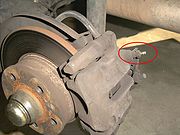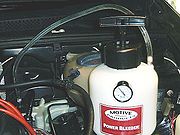
Brake bleeding
Encyclopedia



Brake fluid
Brake fluid is a type of hydraulic fluid used in hydraulic brake and hydraulic clutch applications in automobiles, motorcycles, light trucks, and some bicycles. It is used to transfer force into pressure...
) are purged of any air bubbles. This is necessary because, while the brake fluid is an incompressible liquid
Liquid
Liquid is one of the three classical states of matter . Like a gas, a liquid is able to flow and take the shape of a container. Some liquids resist compression, while others can be compressed. Unlike a gas, a liquid does not disperse to fill every space of a container, and maintains a fairly...
, air bubbles are compressible gas
Gas
Gas is one of the three classical states of matter . Near absolute zero, a substance exists as a solid. As heat is added to this substance it melts into a liquid at its melting point , boils into a gas at its boiling point, and if heated high enough would enter a plasma state in which the electrons...
and their presence in the brake system greatly reduces the hydraulic pressure that can be developed within the system. The same methods used for bleeding are also used for purging, where the old fluid is replaced with new fluid, which is necessary maintenance.
The brake fluid capacity of a typical automobile is around 250ml. Brake fluid
Brake fluid
Brake fluid is a type of hydraulic fluid used in hydraulic brake and hydraulic clutch applications in automobiles, motorcycles, light trucks, and some bicycles. It is used to transfer force into pressure...
is toxic, and must be handled carefully and disposed of properly. Most cars use DOT 3 or 4 Brake fluids, which may be mixed, but DOT 5 is silicone based and not compatible with DOT 3 or 4. One word of caution, most types of brake fluid harm paint and plastics on contact, so be careful. Brake fluid is water soluble so it may be rinsed with water.
The process is performed by forcing clean, bubble-free brake fluid through the entire system, usually from the master cylinder
Master cylinder
The master cylinder is a control device that converts non-hydraulic pressure into hydraulic pressure, in order to move other device which are located at the other end of the hydraulic system, such as one or more slave cylinders...
(s) to the calipers of disc brake
Disc brake
The disc brake or disk brake is a device for slowing or stopping the rotation of a wheel while it is in motion.A brake disc is usually made of cast iron, but may in some cases be made of composites such as reinforced carbon–carbon or ceramic matrix composites. This is connected to the wheel and/or...
s (or the wheel cylinders of drum brake
Drum brake
A drum brake is a brake in which the friction is caused by a set of shoes or pads that press against a rotating drum-shaped part called a brake drum....
s), but in certain cases in the opposite direction. A brake bleed screw
Bleed screw
.A bleed screw is a device used to create a temporary opening in an otherwise closed system, which facilitates the removal of air or another substance from the system by way of pressure and density differences.- Domestic heating radiators :...
is normally mounted at the highest point on each cylinder or caliper.
Please note that the following description of brake bleeding techniques is intended only to provide an overview of the common methods, and is NOT to be used as specific instruction. The actual procedure varies from one vehicle to another and the manufacturers' shop manual procedure should be used.
There are four main methods of bleeding: Pump & Hold (2 variations), Vacuum, Pressure, and Reversed Pressure. Pump & Hold generally requires two people, the other methods can be done by a single person.
- Pump and Hold Method, two people: One person pumps the brake pedal to compress the air, then holds pressure on it. The other person opens the bleeder valve to let out fluid and air, then closes the valve after the pedal has landed (to prevent air being sucked back in through the valve on the upstroke). The process is repeated, usually many times, for each wheel. Typically a length of clear tubing is connected to the bleeder valve and run to a container during the process, both to collect the toxic brake fluid and to better view the fluid and bubbles. The master cylinder reservoir must be replenished frequently, for if it goes dry the entire process must be redone. The cover must be left loose so that the fluid may be drawn, but should be in place so that fluid does not squirt out on the return stroke. A block may be placed under the pedal so that it does not bottom out during this procedure, as the master cylinder seals could be damaged by encountering accumulated sediment and / or corrosion.
- Pump and Hold Method, One Person Option: This uses either a "one man" bleeder tool, consisting of a one way valve at the end of a length of tubing which is attached to the bleeder valve, or a special one way bleeder valve. These methods have the disadvantage that air is sometimes sucked back into the system via the bleeder valve threads, this can be alleviated to a degree by using Teflon tape on those threads. This method is not recommended because with only one person there is no way to verify if indeed the fluid that is coming out of the bleeder valve has any air present, such as from a bad master cylinder or improper/incomplete bleeding.
- Vacuum Method: The master cylinder is topped off and the cover left loose. A specialized vacuum pump is attached to the bleeder valve, which is opened and fluid extracted with the pump until it runs clear of bubbles. Once again, the master cylinder reservoir level must be maintained. The vacuum method can also draw in air via the bleeder threads, so the bubbles will never clear. However, this does not mean there is still air in the brake lines. Using Teflon tape on the bleeder threads will alleviate this issue and allow you to accurately determine when you have evacuated all air from the system.
- Pressure Method: A specialized pressure pump, is attached to the master cylinder and filled with fluid. The pump is used to pressurize the system to about 10psi, and the bleeder valves are opened one at a time until the fluid is clear of air. One advantage to this system is that the pump reservoir usually holds enough fluid that running dry is not likely. This is the method most professional shops use.
- Reverse Pressure Method: In this method, a pump is used to force fluid through the bleeder valve to the master cylinder. This method may have advantages in some cases, however it is not in common usage.
- Gravity method: This method is most simple. Just loosen the bleeder valve and the cap of the master cylinder reservoir. The fluid will drip slowly by the force of gravity. The bleeder valve is designed to be top point of the fluid in the caliper. The air will not enter the caliper downward from the physics law.
The order in which the wheels are bled is specified in the specific vehicle's shop manual. Typically the wheel farthest from the master cylinder is done first, working toward the closest wheel last.
If bleeding brakes because of master cylinder replacement the master cylinder is usually "bench bled" before installation. Typically by securing it on the bench, filling it with fluid, connecting fittings and hoses to route fluid from the outlet ports on the master cylinder back to its reservoir, and repeatedly depressing the master cylinder plunger until bubbles are no longer seen coming from the hoses.

